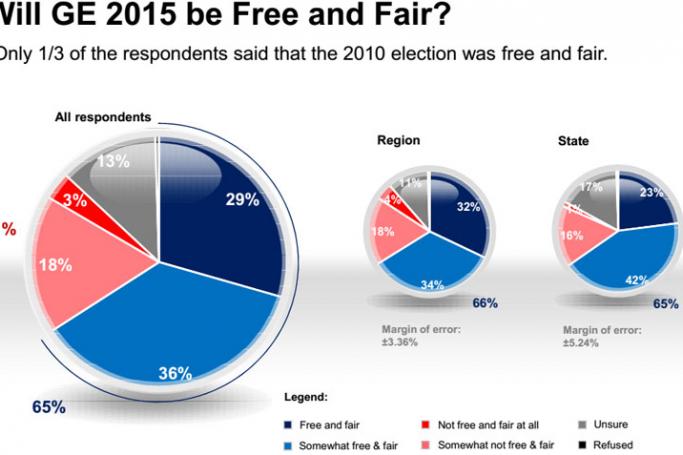Myanmar is “moving in the right direction,” according to 62 percent of the people questioned in a scientific survey conducted by the Mizzima Media Group during the last two weeks of October.
People who said the country was going in the “wrong direction” totaled 21 percent, and 1 percent were “unsure.”
The survey was designed to identify the concerns and measure the motivations of voters prior to the 2015 general election today, November 8.
The survey, conducted in random face-to-face interviews, covered all regions and states spread throughout the country (see the survey methodology at the end of the summary). The survey was conducted in townships, wards and villages, and was a nationally representative sample of respondents.
Respondent profiles
– Of the respondents, 71 percent were non-Bamar and 31 percent were Bamar.
– 71 percent lived in urban settings and 29 percent lived in rural areas. Male and females were represented equally.
National Mood
Respondent opinions
Of those who said the country was headed in the right direction, “economic and infrastructure development” was cited as the top reason for their views.
– 42 percent cited “economic and infrastructure development.”
– 16 percent cited “greater democratic space.”
– 9 percent cited “improvement of education.”
– 8 percent cited “good government.”
– 7 percent cited “the government is bringing about reforms.”
– 4 percent cited “more job opportunities.”
Of those who said the country was headed in the “wrong direction:”
– 19 percent cited “poor economic development.”
– 16 percent cited “poor government performance.”
– 11 percent cited “unresolved conflictions and violence.”
– 11 percent cited “lack of improvement in education.”
– 6 percent cited “fewer job opportunities.”
– 6 percent cited “inflation.”
Household income
When asked about their household income over the past two years:
– 34 percent said they were “better off.”
– 44 percent said they were “about the same.
– 21 percent said they were “worse off.”
Political Awareness
Familiarity with candidates
– 40 percent said they were “not familiar at all.”
– 26 percent said they were “somewhat not familiar.”
– 26 percent said they were “somewhat familiar.”
– 3 percent said they were “familiar.”
– 5 percent were unsure or refused to answer.
Familiarity with political parties contesting the election
– 39 percent said they were “somewhat familiar.”
– 34 percent said were “not familiar at all.”
– 20 percent said they were “somewhat not familiar.”
– 4 percent said they were “very familiar.”
– 3 percent said they unsure or refused to answer.
Internet access and mobile phones
– 41 percent said they had a mobile phone without Internet access.
– 26 percent said “yes, with Internet access.”
– 33 percent said no to having a mobile phone.
Survey Methodology
The survey was commissioned by a consortium led by Mizzima Media Group with the Merdeka Center for Opinion Research (Malaysia) as technical advisor. The survey was carried out by Myanmar Survey Research (MSR).
The number of sampling points broke down as follows:
– Townships: 40
– Wards: 30
– Villages: 85
– Same allocation per same point: 10
– A sample of 1,200 citizens aged 18 and above were interviewed via face to face.
– Respondents were selected through multi-staged random sampling (Kish Grid).
– The sample is nationally representative of the population based on the 2014 census.
– The results are weighted by age, gender and urban/rural. (Age groups were age 18-29, 31 percent; age 30 to 49, 41 percent; age 50-plus, 27 percent.
– The survey covered all regions and states except for Chin State (1 percent of the population).
– The questionnaire was translated into the Myanmar language and while in ethnic states, the interviewers were assisted by local interpreters.
– The survey margin of error is estimated at ±2.83 percent.
– The survey was conducted between 14 October to 31 October 2015.
– Limitations: Chin state was excluded due to accessibility after massive floods.
Myanmar is ‘moving in the right direction’, survey finds
08 November 2015
Myanmar is ‘moving in the right direction’, survey finds












